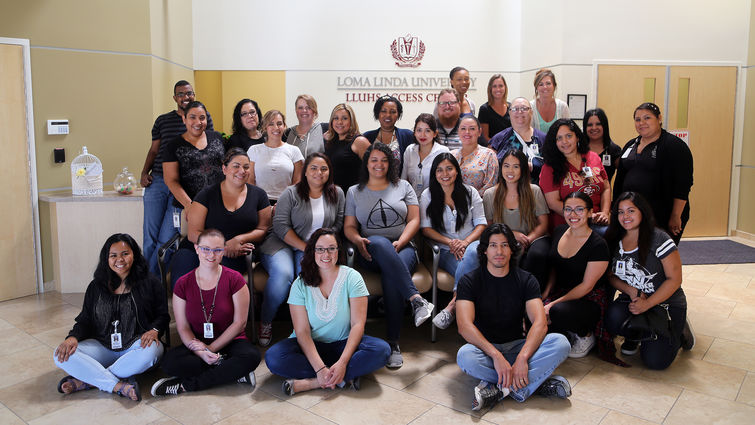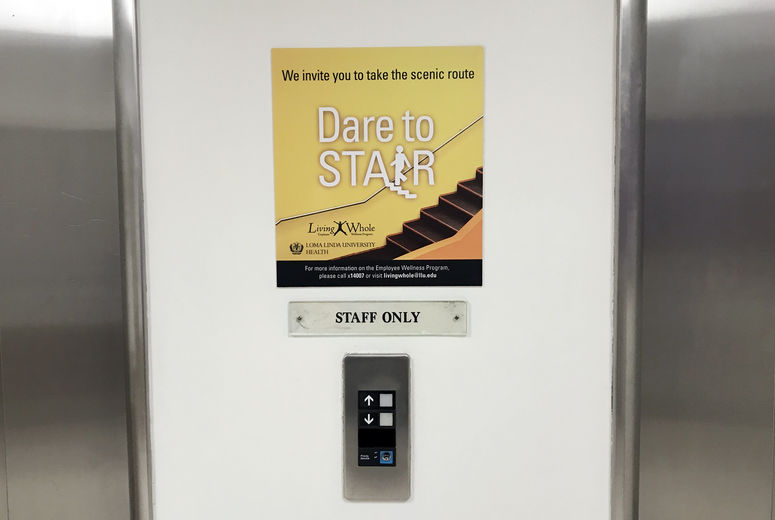
Loma Linda University Health Access Center employees are participating in Battle of the Steps, a 10-week competition designed to help them stay active.
When Candace McCain-Whitaker, a central scheduler, sits at her desk to answer the first of as many as 100 phone calls at Loma Linda University Health’s Access Center, she knows staying active during her eight-hour shift will be challenging.
Research studies are showing that prolonged sitting is a risk factor that can lead to chronic conditions including heart disease and diabetes, prompting the release of an advisory from the American Heart Association.
To help employees combat the dangers of sitting, Loma Linda University Health offers its employees options to help keep them active at work.
McCain-Whitaker joined The Battle of the Steps, a 10-week walking competition developed by the Access Center for its employees. To add to her team’s step count she often takes short walks during her breaks instead of sitting, and has experienced positive benefits from being more active at work. “One week into the competition, I began to feel more energy,” she said.
In three weeks, members of the 32 participating teams have walked more than 20.4 million steps, or an average of nearly 128,000 steps per person.
The goal for creating the competition was to promote physical wellness and movement in a setting where employees sit for most of the working shift, according to Cherisse Carandang, a member of the Access Center’s internal wellness team.
“The camaraderie has been transformative for staff who need the push and want to work on making self-improvements,” Carandang said. “Access Center staff have been more inclined to stand, walk and move during breaks and lunches.”
Aramis Cherrington, director of operations at the Access Center, is a competitive obstacle course racer. “As an all-around super active person it makes me proud to have nearly everyone in my department—160 people—pushing to do more and feel better about themselves in a friendly competition,” he said. “That’s what this is all about.”
As Access Center staff planned The Battle of the Steps, they received guidance from Olivia Moses, DrPH, director of corporate health and wellness. Moses is supportive of employees who find creative ways to promote wellness and stay active, she said.
The Living Whole Wellness Program provides resources to employees that include maps with walking routes, and managers are encouraged to hold walking meetings if two to three staff plan to meet, Moses said. “Both exercise and diet are emphasized in the Say NOW [No to OverWeight] program that is available to our staff,” she said.
The Living Whole Wellness Program was established by Loma Linda University Health’s Department of Risk Management in 2006. This program services all entities of Loma Linda University Health and provides weight management services that are ultimately free to participants, as well as programs that address diabetes and nicotine. The Living Whole Program arose from Loma Linda University Health’s commitment to the health and well-being of its employees and their families.
The importance of keeping active throughout the day
When a person sits for extended periods, chronic inflammation may increase over time. This is a root problem that can lead to cancer, heart disease, diabetes and stroke according to Ernest Medina, DrPH, an assistant professor at the Loma Linda University School of Public Health.
Medina often lectures about the importance of keeping active. With prolonged inactivity, LDL (bad cholesterol) levels increase and HDL (good cholesterol) levels go down, he said. While federal guidelines recommend 150 minutes of moderate exercise for adults each week many people don’t exercise at all.
To emphasize the importance of keeping active, Medina cites a study titled “Sedentary time and its association with risk for disease incidence, mortality, and hospitalization in adults: A systematic review and meta-analysis,” that was published in Annals of Internal Medicine in 2015. The study found that sitting for too long is independently associated with negative health outcomes, regardless of how much physical activity a person completes, he said.
“If people would exercise for just 30 minutes a day, five days a week, it would have a huge impact on public health,” he said. “However, risk remains when a 30-minute workout is followed by hours of sitting.”
Exercising is like taking a multivitamin, but if it is followed by eight hours of sitting it’s like eating fast food for the rest of the day, Medina said. “Thirty minutes at the gym is not enough to offset a fast food diet,” he said.
In order to offset the negative effects of a sedentary lifestyle it is important to get up and move every hour, even if it’s just for a few minutes, Medina said. “That includes just standing up and marching in place. It’s that simple—every hour, get out of your chair and move for three minutes,” he said.
Tips to stay active
Caitlin Mckee, MS, RD, a weight management dietitian at the Loma Linda University Health Employee Wellness Program, provides these tips to stay active at work:
- Take micro breaks during the work day. Walk to get water or take a lap around the office on your way to the restroom
- Stand and stretch at your desk; stand while talking on the phone
- While standing practice active standing—move and shift your feet around
- Walk during breaks or for a portion of your lunchtime
- Use the stairs instead of the elevator; if you are taking the elevator up several floors exit early and walk up a floor or two to reach your destination.Top of Form
For information about the dangers of inactivity and tips on how to stay active throughout the day, see Standing, episode 4 of Live It, Loma Linda University Health’s online health show.

